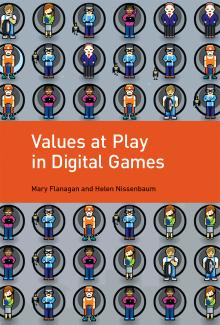A Discussion on Mary Flanagan’s Presentation on Games, Design and Values.
With Amanda Kok and Nicholas Turner
Games have evolved with technology – from the traditional dice and card games, to the classic board games, to computer and television console games. The growth and accessibility of games, especially with the rise of smartphones, have led to games playing a significant role in our lives. What I found interesting in Mary Flanagan’s talk was her focus on how gameplay can be a platform to convey values and the power it has to shape people’s beliefs.
I took away the same emphasis on values and what games can do within communities. Though I do not spend much time in my everyday life playing games (save for the subway escape into Candy Crush), Mary Flanagan’s talk generated many questions in my mind such as: How might we think of games as a tool in building a better global society? How can we newly embarked grad students take this concept of personal and societal values within gaming and game design and apply the philosophy of personal responsibility towards improving the conditions of peoples’ lives in our own communities and around the world?
Mary Flanagan’s Presentation on Games, Design and Values
Ava Hill Caroline O’Connor Amanda Ortiz Lauren Gary
“It is this fruitful tension between concrete and the abstract with which I play to create my work.”
– Mary Flanagan
 Mary Flanagan is an extraordinary example of entrepreneurship in digital media. Her prominent voice in the world of technology is continuing to break boundaries by investigating technology, specifically games and human dynamics, while focusing on values at play. Some of her work includes “Critical Play: Radical Game Design,” a self-created
Mary Flanagan is an extraordinary example of entrepreneurship in digital media. Her prominent voice in the world of technology is continuing to break boundaries by investigating technology, specifically games and human dynamics, while focusing on values at play. Some of her work includes “Critical Play: Radical Game Design,” a self-created game research lab, Tiltfactor, and her new book, Values at Play in Digital Games, co-authored by Helen Nissenbaum. As she studies the relationships between behavior, tools, play and daily life, Flanagan shines a necessary light on how we can strive to make and use technology more positively. She continues to influence designers and consumers by investigating how the world can be changed through values at play.
game research lab, Tiltfactor, and her new book, Values at Play in Digital Games, co-authored by Helen Nissenbaum. As she studies the relationships between behavior, tools, play and daily life, Flanagan shines a necessary light on how we can strive to make and use technology more positively. She continues to influence designers and consumers by investigating how the world can be changed through values at play.
Mary Flanagan’s talk at the New School on September 15th, 2014, was an illuminating entryway to the world of game ethics. Mary spoke about her own research on how our value systems influence our game-playing (both video and analog) and also about how we, as a society, interpret values across many of our different media types. Her presentation was a clear introduction to why research methods matter, and why questioning our own values was important to interpreting the media we produce and consume.
For our synthesis of Mary’s talk, we wanted to produce something that might both illustrate her concepts and our own judgements. We decided to create a kind of “game” that you can play within this post. The game is meant to be both a bit confusing and slightly difficult to parse, just as is often the case with our own values.
Nwamaka Hunter Jon Schober Adrian Wagner Nan Zhang
Transmedia producer Caitlin Burns has contributed greatly to the world of storytelling, as she has worked on numerous multi-platform stories such as Pirates of the Caribbean and Disney’s Tron Legacy. Undoubtedly, Burns illustrates an understanding of creating and developing successful stories across media platforms, and when she spoke for the Understanding Media Studies Lecture Series, she shared her insights on the matter.
Tyler Clements Adam Harden George Hull Gregory Mania Nelesi Rodriguez
Urban Screens as community platforms: A reflection on the boundaries, the potential, and the challenges of this medium
Probably the first image that comes to mind when one hears the expression “urban screen” is one of Times Square: intrusive, stereotypical, offensive, manipulative, superficial, and wasteful. Yet even if the Times Square-style spectacle is indeed one example of urban screens, this medium needn’t be reduced to an advertising tool for corporations.
Susa Pop, urban media curator and managing director of the Berlin Public Art Lab, gave a presentation in an Understanding Media Studies lecture at The New School, in which she talked about urban screens as community platforms. She defines these devices as “membranes that are between the urban space and the digital world”. She also identifies the phenomenon as an index of gentrification – they tend to appear with commercial development and increasing property values — a situation that raises questions about the relationship between these projects and the communities in which they are created. According to Susa Pop, these “membranes” can have different sizes and looks. She categorizes the display`s formats as follows: Urban Screens (i.e. billboards), Media Façades (i.e. projections on buildings walls), Media Architectures (using not only the wall, but the whole building as structure for projection and interaction), and Urban Media (i.e. mobile cellphones).